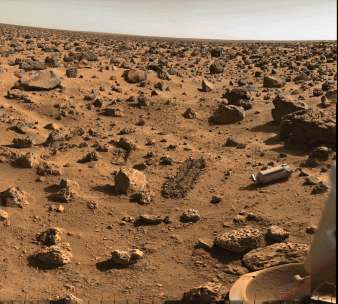|
|
|
|
(P-5) Mars
|
----------------- Jupiter moons ----------------- to Galileo |
Mars is the outer planet closest to us, and seems in some way most Earth-like: it rotates in a little more than 24 hours, it has a thin atmosphere and extinct volcanoes, and its inclination to the ecliptic is close to Earth's, creating seasons similar to ours (though nearly twice as long, since the "year" is also close to two of ours). The telescope shows white polar caps with seasonal changes, and its surface (see image below, from the Viking 2 lander of NASA) looks like windblown desert of the southwestern USA--a surface of boulders exposed by windstorms.
|
 Mars is also extremely cold--at noon in summer, near the equator, the temperature may get above the freezing point of water, but barely, and so far, signs of liquid water are elusive (though temporary flows may follow comet impact). Gravity is about one-third of Earth's, which may explain why Mars retained much less atmosphere than our own planet did.
Mars is also extremely cold--at noon in summer, near the equator, the temperature may get above the freezing point of water, but barely, and so far, signs of liquid water are elusive (though temporary flows may follow comet impact). Gravity is about one-third of Earth's, which may explain why Mars retained much less atmosphere than our own planet did.
Note the reddish color of the ground, sign (here and in the US Southwest) of a high content of iron. Mars also appears red in the sky ("the red planet"), which is why a prominent reddish star in the constellation Scorpio was named "Antares"--the counterpart (anti-) of Ares, the Greek equivalent to Mars, god of war. The fast motion of Mars among stars suggested it was relatively close. Even before the invention of the telescope, Tycho tried to deduce its distance, using parallax methods and the change in position due to the Earth's rotation; he thought he had succeeded, but he was wrong.
Kepler's laws later allowed the radii of planetary orbits to be calculated in units of the Earth's radius. It was then realized that by measuring any actual distance between planets in miles or kilometers--e.g. by the parallax method--would calibrate the scale of planetary distances in the solar system. Using a telescope, Jean Richer in 1672 obtained the first crude estimate of the distance of Mars, providing an estimate of the actual size in the solar system.
Is there life on Mars? The Viking landers (1976) conducted elaborate biochemical experiments but so far have found no proof. Several NASA rovers have landed on Mars since then, most recently (5 August 2012) "Curiosity" with a mass close to one ton was landed in Gale Crater and is now (2014) slowly advancing towards Mt. Sharp. Interest was also aroused by some unusual meteorites recovered from the Antarctic icecap, said to have been ejected from Mars and containing tiny structures which some saw as fossils. So far, great doubt remains, but stay tuned. Will a human explorer set foot on Mars--say, before the end of this (21st) century? Again, very doubtful (see here about the orbital requirements). However, robot explorers have landed there and explored limited areas of the planet, powered by sunlight, and given expected progress in computer intelligence, this may prove a more fruitful approach. If humans ever fly to Mars, they will probably use one of the planet's tiny moons, Phobos and Deimos, as way stations, since landing there is much easier than on the planet itself, and rovers can be controlled from there without great signal delay. Perhaps even rocket fuel may be manufactured there, for a descent and for a return trip. (And for science fiction buffs: look up Arthur Clarke's "Hide and Seek," whose action takes place on Phobos.)The image above is of the volcano "Olympus Mons", rising about 25 km above Mars. Its height is made possible by the planet's weak gravity: if such a mountain were placed on Earth, its weight would cause its base to gradually sag, leaving a height comparable to that of terrestrial mountains. Much more can be said about Mars (see tabulations). It has a great canyon (perhaps carved by comet impact, perhaps by rifting) with features attributed to flowing water, and also a moderate magnetic field which seems to originate fairly close to the surface. |
Next Planets: #P-6 The Asteroids
Next Stop (following "The Planets"): #9c The Discovery of the Solar System, from Copernicus to Galileo
Timeline Glossary Back to the Master List
Author and Curator: Dr. David P. Stern
Mail to Dr.Stern: stargaze("at" symbol)phy6.org .
Last updated: 10 October 2016
 The notion of life on Mars also captured the imagination of fantasy fiction ("science fiction" was a later term). Edgar Rice Burroughs, creator of "Tarzan," wrote imaginative tales of a princess on Mars, now rightly forgotten. In 1897 Herbert George ("H.G.") Wells wrote "The War of the Worlds" about an invasion of intelligent Martians, which is still very readable (a film version also exists). In 1938 Orson Wells dramatized "War of the Worlds" as a radio broadcast report of an alien invasion unfolding in New Jersey, panicking listeners who had missed its beginning and imagined it was a real event.
The notion of life on Mars also captured the imagination of fantasy fiction ("science fiction" was a later term). Edgar Rice Burroughs, creator of "Tarzan," wrote imaginative tales of a princess on Mars, now rightly forgotten. In 1897 Herbert George ("H.G.") Wells wrote "The War of the Worlds" about an invasion of intelligent Martians, which is still very readable (a film version also exists). In 1938 Orson Wells dramatized "War of the Worlds" as a radio broadcast report of an alien invasion unfolding in New Jersey, panicking listeners who had missed its beginning and imagined it was a real event.
